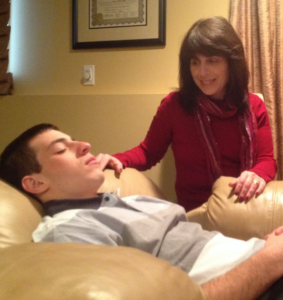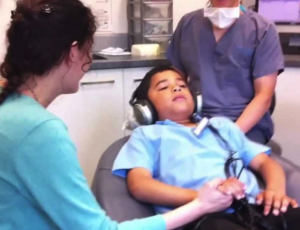
Hypnosis: grounded in science
 Last summer, at age 14, Sue Jones suffered from stabbing pains in her abdomen that got so intense, “I couldn’t walk.”
Last summer, at age 14, Sue Jones suffered from stabbing pains in her abdomen that got so intense, “I couldn’t walk.”
She spent three weeks in a wheelchair while doctors ruled out everything from digestive problems to appendicitis. Finally, after a four-night stay at BC Children’s Hospital in Vancouver, she got a diagnosis: acute anxiety.
An honor student, Sue is thin, dark-haired and lily pale. (Her parents requested a pseudonym to protect her privacy.) When a doctor recommended hypnosis, she balked at first. “I thought of it as black magic, like witchcraft,” she says. But neither breathing exercises, nor anti-depressants, had taken away the pain.
So, in early September, she visited Dr. Leora Kuttner, a pediatric psychologist who specializes in clinical hypnosis, a technique for leveraging the brain’s healing abilities during a trance state.
Kuttner’s office has a rumpus-room feel, with toys, plants and colorful pictures scattered about. Settling into a plump beige armchair by the window, Sue breathed slowly as the psychologist asked her to “go to a quiet place.” She chose a beach. Then, in a soft, soothing voice, Kuttner suggested that she imagine a “protection skirt” that could shield her from stomach pain.
Sue pictured herself covered in “a golden, shimmery, transparent cocoon, floating up in the air above this beach.” For a few moments, she felt as though she had left the room. When Kuttner called her out of her reverie, “I was surprised where I was.” Another surprise: the pain was gone.
Sue keeps a recording of her “protection skirt” hypnosis handy on her phone – all 5 minutes, 56 seconds of it. She is still learning to keep anxiety at bay, but if the abdominal pain ever comes back, she says, “I know how to deal with it.”
Hypnosis isn’t just for hucksters and Hollywood villains any more. Neuroscience studies have shown that this mind-body therapy affects the brain in extraordinary ways. Clinical trials have demonstrated its effectiveness in treating anxiety, phobias, skin rashes, irritable-bowel syndrome and acute and chronic pain.
In France and Belgium, anesthesiologists are offering hypnosis combined with local anesthetic as an alternative to general anesthesia in surgery. In North America, medical centers such as the Mayo Clinic have added hypnosis to their pain-management tools.
Hypnosis doesn’t work for everyone, notes Dr. Amir Raz, Canada Research Chair in the cognitive neuroscience of attention at McGill University and the Jewish General Hospital in Montreal. But “in my opinion, it’s completely underused.”
That may be changing, especially in pediatrics. Over the past four years, Kuttner has been invited to teach hypnosis at the Mayo Clinic, Alberta Children’s Hospital in Calgary and the Hospital for Sick Children in Toronto. Kuttner, who developed her techniques more than three decades ago, says she’s “thrilled” by the uptake.
As with mindfulness meditation, hypnosis harnesses the brain’s natural abilities to regulate the body and control the random thoughts that ricochet through our minds, says Dr. David Patterson, a University of Washington psychologist who has studied hypnosis since the 1980s, in a series of clinical trials financed by the U.S. National Institutes of Health.
But, he adds, meditation can take weeks or months of practice before it helps patients dial down pain. With hypnosis, “the relief is just a lot quicker and more dramatic.”
Hypnosis reduces our awareness of what’s going on around us, even as it increases our attention and openness to new ideas. The brain’s  command center lets its guard down, allowing the therapist’s suggestions to embed themselves into the parts of our grey matter that regulate our thoughts, perceptions and physiology, Patterson says. “It’s as if you’re talking directly to the brain.”
command center lets its guard down, allowing the therapist’s suggestions to embed themselves into the parts of our grey matter that regulate our thoughts, perceptions and physiology, Patterson says. “It’s as if you’re talking directly to the brain.”
At Legacy Oregon Burn Center in Portland, Ore., Dr. Emily Ogden, a psychologist, uses hypnosis to help patients cope with the most excruciating injuries you can have.
In the facility’s bedroom-sized intensive-care units, machinery for monitoring vital signs beeps nonstop as nurses and doctors cut away layers of clothing and scorched flesh. The air is putrid-sweet, the smell of open wounds.
Often, the pain of the burn itself pales next to the agony of having dead tissue removed in a process called debridement, or a patch of healthy skin shaved and grafted onto a wound. Then there are the dressing changes. Every day or so, nurses replace fluid-soaked gauze to prevent a burn victim’s greatest threat: infection. The sudden gust of cold air on exposed wounds can be torturous, even with painkillers.
Burn patients tend to be open to hypnosis, Ogden says, but they often add something such as, “I’m not going to squawk like a chicken, am I?”
After reassuring them that no, she won’t make them cluck, Ogden stands by the bedside and asks the patient to imagine stepping down a flight of stairs as she counts backward from 20. Once the patient is deeply relaxed, she gives a series of hypnotic “suggestions,” or instructions for the brain.
For example, “When a nurse touches you on the shoulder, you will return to the feeling of relaxation you have now,” she might say. “During the procedure, you will have no feelings other than comfort and relaxation. Later, you’ll be surprised at how easily it goes for you.”
As simple as it sounds, the technique usually works, says Ogden, who began offering hypnosis six months ago. “It has proven to be such a beneficial and effective intervention.”
Hypnosis stimulates specific brain activity, according to a 2016 study from Stanford University. Researchers found three brain changes in adults who scored high in susceptibility to hypnosis and these changes occurred only while they were hypnotized.
Using a brain-imaging technique called fMRI, researchers found decreased activity in the brain’s salience network, the inner “air-traffic controller” that processes stimuli and preps us for action.
Secondly, they saw greater connectivity between the brain’s executive-control network and the insula, a grape-sized region deeper in the brain that helps us “control what’s going on in the body, and process pain,” the study’s co-author, psychiatrist Dr. David Spiegel, says.
Finally, the researchers observed reduced connections between the executive-control center and the “default-mode” network, involved in self-reflection. This could lead to a disconnect between a person’s actions and their awareness of their actions, Spiegel says.
He describes hypnosis as a “very powerful means of changing the way we use our minds to control perception, and our bodies.” If more practitioners had training to use it, hypnosis could make “a huge difference” in the opioid epidemic, he adds.
In a previous study, published in The Lancet, Spiegel and colleagues instructed patients in self-hypnosis techniques before they underwent vascular or kidney procedures.
Compared with patients receiving standard care, the hypnosis group used significantly less pain medication (fentanyl and midazolam). Spiegel’s team is now testing the same approach in knee- and hip-surgery patients.
He notes that the risk of addiction increases when people are on opioid painkillers for more than three days. If patients can get through the post-surgical period faster, “you can prevent them from getting hooked.”
 But hypnosis has an image problem. Unlike mindfulness, it lacks Zen-master cachet. Doctors and patients have trouble forgetting the dangling pocket watches of stage hypnosis, or the bad guys who put sleeper agents under “mind control” in movies such as The Manchurian Candidate.
But hypnosis has an image problem. Unlike mindfulness, it lacks Zen-master cachet. Doctors and patients have trouble forgetting the dangling pocket watches of stage hypnosis, or the bad guys who put sleeper agents under “mind control” in movies such as The Manchurian Candidate.
Despite solid evidence from clinical trials, the medical field’s approach to hypnosis has been “extremely careful and conservative,” Raz says.
And let’s face it: For every credible scientist studying hypnosis, there are hundreds of charlatans touting self-hypnosis CDs or sessions on Skype as a miracle cure for everything from obesity to cancer. In the land of psychics and crystal magic, anyone can become a “certified hypnotherapist” in a month or less. Rampant quackery “gives us a bad name,” Patterson says.
Adults tend to insist they are impervious to hypnosis, even if they’ve never tried it, Raz says. They think of it as “feeble-mindedness, or the ability to be manipulated.”
But in fact, people who respond to hypnosis may have better co-ordination between brain areas that “integrate attention, emotion, action and intention,” according to a 2012 study published in the Archives of General Psychiatry.
About 10 to 15 percent of adults are “highly hypnotizable,” meaning they can easily slip into a trance and act on hypnotic suggestions. The same percentage of adults do not respond to hypnosis at all, while the rest are somewhere in between. The trait may be genetic, researchers say. But imagination also plays a role.
Responsiveness to hypnosis reaches its peak between the ages of 8 and 12, says Kuttner, who began using hypnosis in the mid-1980s to help children cope with pain in the oncology ward at BC Children’s Hospital.
She documented her techniques in No Tears, No Fears, a short film featuring eight kids with cancer, aged 3 to 12. Guided by Kuttner, the children went through procedures such as spinal taps with only local anesthetic at the needle site. (At the time, general anesthesia in children was reserved for special circumstances, such as major surgery.)
Most children can easily imagine an invisible “magic glove” that keeps needles from hurting, or a fantasy world free of pain, Kuttner says. Concentrating on these beliefs can have analgesic effects. With a fond smile, she recalls a child with leukemia who spent her treatments in an imaginary land of candy.
A more recent patient, 17-year-old Isabella Hay, says working with Kuttner helped her overcome muscle twitches and symptoms of obsessive-compulsive disorder. Starting at the age of 4, Isabella learned to visualize entering a room and turning off switches that controlled her nervous ticks.
When Isabella received a diagnosis of OCD at the age of 13, Kuttner taught her how to focus on her breathing and picture herself in calm place, using a form of self-hypnosis. The technique has given her control over compulsive behaviors, such as a need to touch a rock a certain number of times, Isabella says.
She used to feel panicky at the idea of sleeping away from home. Now, she is graduating from high school with acceptance letters from both the University of British Columbia and Queen’s University. Knowing that the brain is strong enough to “transport you from the thoughts,” Isabella says, “I feel more secure and confident, and less vulnerable in my own head.”
Hypnosis techniques are relatively easy for health-care professionals to learn, Kuttner says. But like other specialists interviewed for this article, she cautions patients against seeking hypnosis from someone with no medical training. “Things can go haywire.”
A lay hypnotist could fail to recognize the signs of psychosis, or encourage someone to regress to an earlier life stage filled with traumatic memories, “and they won’t have a clue how to help the person.”
Kuttner recalls treating a patient who had gone to a lay hypnotist for headache relief but came away weeping and confused. Hypnosis needs to be in the hands of “someone who respects it, and knows what they are doing,” she says. “This is powerful stuff.”
In hypnosis circles, the word “powerful” comes up a lot. But it’s hardly an overstatement when you consider the work of Dr. Marie-Elisabeth Faymonville, director of the pain clinic and palliative care at the University Hospital of Liège, Belgium.
Hypnosis allows patients to avoid general anesthesia in surgeries ranging from mastectomies to heart-valve replacements, Faymonville says.
Since 1992, she has treated more than 9,500 surgery patients with “hypno-sedation,” combining hypnosis with small amounts of local  anesthesia. Of those patients, just 18 had to switch to general anesthesia. “It’s really rare,” she says, in German-accented English.
anesthesia. Of those patients, just 18 had to switch to general anesthesia. “It’s really rare,” she says, in German-accented English.
The method appeals to patients who want to be “aware during surgery, but comfortable.” Patients do not get a dry run. Instead, Faymonville assesses their level of motivation and confidence in the surgical team, and their ability to co-operate.
Hypno-sedation works because the patient wants it to work, she says: It’s the opposite of “mind control.” The anesthesiologist’s job is to use hypnotic techniques and communicate with the patient, but the patient must collaborate, “so he puts himself in the hypnotic state.”
She emphasizes that unlike the cross-section of patients you might find in the average hospital, her patients are “highly motivated” to stay conscious during surgery. But in general, she adds, doctors tend to underestimate the resources patients can access with their own minds. “Hypnosis is a talent, a gift from nature.”
THE GIFT OF HYPNOSIS
The ability to be hypnotized is a talent, like an ear for music, researchers say. The easiest way to know if you have it is to give it a try. So, I ask Dr. Lance Rucker, president of the Canadian Society of Clinical Hypnosis, if he’ll hypnotize me.
A dentist by training, Rucker teaches hypnosis to third-year dentistry students at the University of British Columbia, where it’s part of the required curriculum.
Dentists need to learn the basics of hypnosis to “avoid abusing the trance state,” he says. People drift in and out of light trances throughout the day, whether they’re on “autopilot” for the daily commute, or so engrossed in an X-Men flick that they forget it’s a movie.
Dental patients – triggered by memories of needles, drills and frozen-gums past – are often in a daze even before they lie on the chair. When patients are in this vulnerable state, a dentist’s soothing words (“let’s make sure you’re comfortable”) can help make it so. On the flip side, stock phrases such as, “this might hurt a little,” may intensify pain and fear, he says.
Rucker emphasizes that reputable practitioners will not use hypnosis for purposes outside their medical specialty. He asks if I have a dental issue I’d like to resolve. An overactive gag reflex, perhaps? Or a fear of dental fillings?
I am definitely a grinder. That may not be easily fixed, depending on the root cause, he replies. But he’s willing to give it a go.
We sit in the front seats of his scarlet Acura, parked outside a cluster of big-box stores near his home in Burnaby, B.C. The windows are closed to shut out the rumble of traffic and the air is warm and stuffy. I am drowsy already.
In a soft, calm voice, Rucker asks me to take myself to “an internal space, a creative space.” As I relax, he says, my inner awareness can let me know “what it’s all about, and has been all about – the clenching, the grinding.”
A symbol or realization may come to mind. He pauses for a few moments. Then he suggests that I ask my inner self whether it can let the grinding go, “or whether there is some part of you that may wish to hold on to it.”
As his voice meanders, I have a clear picture of a big black dog with massive metal jaws. Could my clenching be a hard-wired defense mechanism? It’s an obvious symbol. But as it turns out, my inner guard dog refuses to back down easily. Later that day, my jaw feels as tight as ever.
A life-long grinding habit could be a problem that a single session in a parked car cannot solve. I might give hypnosis another try. But maybe I just don’t have the gift.
By: Adrianna Barton


 Melissa Cipriana had no explanation left for why she couldn’t lose weight. She avoided processed foods, “white” carbohydrates and soda. She attended SoulCycle classes religiously. And she certainly had discipline: She had already lost – and kept off for years – 50 pounds through a medically supervised hCG diet, which involves eating less than 800 calories a day and receiving injections of a hormone marketed to suppress appetite.
Melissa Cipriana had no explanation left for why she couldn’t lose weight. She avoided processed foods, “white” carbohydrates and soda. She attended SoulCycle classes religiously. And she certainly had discipline: She had already lost – and kept off for years – 50 pounds through a medically supervised hCG diet, which involves eating less than 800 calories a day and receiving injections of a hormone marketed to suppress appetite. very relaxed, focused state; like CBT, it involves noticing and challenging negative thought patterns.
very relaxed, focused state; like CBT, it involves noticing and challenging negative thought patterns. Even if you do have a natural affinity for hypnosis and a genuine goal, finding an appropriately trained therapist who’s right for you can be complicated since there’s no single credentialing organization, state licensing rules differ (when they exist at all) and hypnotherapists may include physicians, nurses, dentists, social workers, psychologists and regular Joes. “All the time I see people who will say things like, ‘I’m a certified hypnotherapist,'” Spiegel says. “The question is, ‘OK, what are you certified in and what is your professional degree and do you have a license?'”
Even if you do have a natural affinity for hypnosis and a genuine goal, finding an appropriately trained therapist who’s right for you can be complicated since there’s no single credentialing organization, state licensing rules differ (when they exist at all) and hypnotherapists may include physicians, nurses, dentists, social workers, psychologists and regular Joes. “All the time I see people who will say things like, ‘I’m a certified hypnotherapist,'” Spiegel says. “The question is, ‘OK, what are you certified in and what is your professional degree and do you have a license?'” It has previously been shown to decrease the need for medication, reduce adverse effects, and to accelerate postoperative rehabilitation when compared to general anesthesia in which the patient is rendered unconscious.
It has previously been shown to decrease the need for medication, reduce adverse effects, and to accelerate postoperative rehabilitation when compared to general anesthesia in which the patient is rendered unconscious.

 Clinical hypnotherapy has been gradually gaining momentum in the medical mainstream as a legitimate tool supporting healthy change. I have been in practice since 2001, and in the past 5 years the number of clients looking for help related to medical conditions has grown significantly.
Clinical hypnotherapy has been gradually gaining momentum in the medical mainstream as a legitimate tool supporting healthy change. I have been in practice since 2001, and in the past 5 years the number of clients looking for help related to medical conditions has grown significantly.
 This study also reported that the hypnosis group saved $772/patient mainly due to reduced surgical time. These patients also required less analgesic lidocaine and the sedative propofol during surgery. (Journal of the National Cancer Institute 2007)
This study also reported that the hypnosis group saved $772/patient mainly due to reduced surgical time. These patients also required less analgesic lidocaine and the sedative propofol during surgery. (Journal of the National Cancer Institute 2007)







